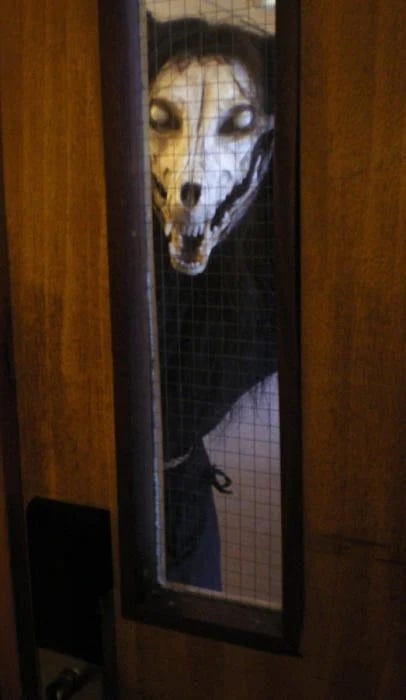The Hyperreal Mystery of Roy Jay
You'll remember him soon enough, and you'll all be doing it tomorrow.
On April 4th, 2025, an anonymous user on the /x/ board of 4chan, devoted (ostensibly) to the discussion of the paranormal and supernatural, posted this picture.
With it, they wrote:
This is a demon writing itself into retroactively into pop culture history. You'll think this is a shitpost, but youll remember him from your childhoods soon enough.
Now, I spent a lot of time on /x/ many, many years ago. It’s a corner of 4chan I’m very familiar with. It takes something significant to attract attention on the board, let alone spark an investigation. Posts like these - cryptic, odious statements, posted in tandem with an odd image - are about as common as flies in an outhouse. And, like most flies, they come and go without most people noticing them, and if they do, the most they afford them is a dismissive wave. Most are just people LARPing as shady government insider/whistleblower, comedically overwrought attempts to kickstart an Alternate Reality Game, or just run-of-the-mill piss taking.
And, for a moment, it seemed as if this thread and the warning attached to it would be just another low-effort shitpost that would be lost to time, doomed to wash away into the digital gutter beneath a torrent of low-effort horror greentexts1, spooky picture threads, and posts about how badly a concerning amount of people want to bop that one SCP with the dog skull.
Yet, as the usual tide of replies reading fake and gay or my uncle works for the CIA he told me this was true rolled in, more astute users found themselves intrigued by the image. Something about it seemed… off. The plain, mustard-yellow background. The absurd pinstripe nightgown and cap get-up, which was giving off some old school, Ebeneezer Scrooge, Who goes there? vibes. The strange pose. More than anything, it was the eyes.
Something about the man in the image’s eyes… some said that it seems as if the man was looking through the computer screen, right at them. Most posters saying that were probably goofing. But the longer I looked at them, the more they did seem a bit skew-whiff. There’s an uncanny quality to them. Like they didn’t quite belong on the face they were on. More than that, his smile, as some would say, doesn’t reach his eyes.
Never a good sign.
Naturally, curious /x/philes took the first step that any enterprising internet gumshoe takes when investigating a bizarre picture posted on an obscure Tibetan Shadow Play forum - the good ol’ reverse image search. Your best friend when it comes to finding the sauce2. Never forget it.
However, when they plugged the file - named roy_jay_pjs.jpg - into their reverse image search service of choice…
No dice.
Multiple users reported, even screencapped, the fact that saucenao, tineye, Google, and other reverse image search services had failed to find any results for roy_jay_pjs.jpg.
This result can sometimes have disturbing implications.
It implies, though not necessarily guarantee, that this image was made by the OP. At the very least, it suggests that the image posted is very rare, if not outright inaccessible by most standard search engines.
Naturally, this piqued the intrigue of many /x/ users who stumbled across the thread, and saved it from being clowned off the site and into the dustbin of internet history.
With no leads from the image itself, users began to search the words in the file name - roy_jay. Was it a name? No one could say, but it seemed as if it could be.
Google searches for Roy Jay similarly ended at an impassable brick wall. This isn’t terribly surprising; Roy and Jay not terribly uncommon names, albeit not exactly found often in that order. That, and we can all agree that Google, post the advent of generative AI and the company’s aggressive attempts to turn the entire first several pages of results into a worse version of Temu.com, works about as well at actually finding what you’re looking for as a wet sheet of toilet paper works at cleaning your ass.
Now, frequenters of /x/ have a reputation of being schizo. I’m fairly certain it’s actually where the term as we use it on the internet originated. It has less to do with clinically diagnosed schizophrenia, schizoaffective disorder, or any other kind of diagnosis psychosis, and generally became a catch-all pejorative for those who are willing to humor… less than conventional explanations to relatively mundane phenomenon. These days, it’s also (mis)used by quirked up white girls on TikTok who think talking about lead in Stanley cups like it’s a conspiracy and not a fact makes them the #girliepop equivalent of Fox Mulder.
And, don’t get me wrong - there is no shortage of netizens, on /x/ and elsewhere, who have fried their brains by binging content farms on YouTube Shorts that just post ChatGPT’d summaries of books written by Zechariah Sitchin and Bob Lazar.
But these types of True Believers are in the minority.
Some people who stumbled across the thread and saw that roy_jay_pjs.jpg was nonexistent outside of this one 4chan post assumed it was exactly the very thing that’s made the internet borderline unusable and equally intolerable since 2023 - it was the product of generative AI.
It would make sense. The simple explanation was that the image was unavailable anywhere else because the user has cooked it up with Grok or ChatGPT, maybe tossed it in Photoshop afterwards to put on a bit of that vintage glaze, and posted it for a low-effort spook and get the schizos on /x/ all riled up like tossing a rubber snake into an orangutan enclosure.
That, and roy_jay_pjs.jpg does just kind of have that look to it, doesn’t it?
Though generative AI is improving - rapidly so - after almost three years of being subjected to a never-ending deluge of content hallucinated by algorithms, those with more than two braincells sharp eyes have learned to spot the tells in images generated by them. It’s difficult to articulate what those tells are, exactly, but much like pornography, you just kind of know when something is made by generative AI when you see it. As a friend of mine likes to say, images made by generative AI just have a certain stank to them.
And, again, that seemed to be where the investigation stalled out. But while most were willing to let the story end there, others… they weren’t quite so convinced. In fact, they were certain that the image was not generated by AI.
A small handful of folks… something about the man sparked some long dormant memory, as indistinct and unclear as a half-remembered dream. They couldn’t remember where, when or why, but… they’d seen him before. Even the name - Roy Jay - had a familiar ring to it.
A small cadre of True Believers saw this as the fulfillment of OP’s comment - you’ll remember him from your childhoods soon enough.
The demon was hard at work, it seemed.
Of course, many didn’t buy their claims. Skeptics handwaved them away as the LARPers looking to perpetuate the hoax, to make the whole thing into some sort of meme or legendary story that would be reposted on /x/ for years to come.
Right up until one of /x/’s internet sleuths made a disturbing discovery; a Facebook group titled Spook! Slither! The genius who was Roy Jay.
The description read as follows:
Naturally, this discovery threw /x/ into a frenzy. How had this page been overlooked? For weeks, they’d scoured the internet, utilizing every search engine available, searching for any shred of a Roy Jay, only to come away empty handed. And now, seemingly as if it had spawned of it’s own accord - or perhaps been planted there for them to find - was a Facebook group dedicated to this man who seemingly didn’t exist.
There was even another picture of this supposed Roy Jay - a signed copy of a record that no one had ever seen before, even in the darkest depths of a second-hand record store by the most obnoxious music snob.
Some were quick to point out the fact that this discovery could mean nothing. After all, it isn’t difficult to make a Facebook group. It was well within the bounds of possibility that whoever had made the thread, or perhaps someone looking to keep the joke going, had made it, as well as utilized the same generative AI as the original poster to cook up a picture of a fake record. The small following of a hundred Facebook users could be explained away by two possibilities; one was that the average Facebook junkie is often willing to click on any page and follow tens of thousands of groups dedicated to any old shit. The other, more likely explanation, is that they were all spambot accounts that are programmed to follow quite literally any and every page they came across.
This Facebook page could have just been a strategically laid, carefully crafted breadcrumb to keep them on a trail to nowhere. If this was another Alternate Reality Game, which had a habit of (attempting) to begin on /x/ by baiting in their infamously tenacious and sometimes gullible users into getting their projects started, this would be standard practice for the craft.
These would be perfectly rational explanations.
But it didn’t explain how the Facebook Group was made seventeen years ago.
Remember what the OP said? This is a demon writing itself into(sic) retroactively into pop culture history.
Yeah - there were more than a few people who were suddenly not so sure that this was just another random shitpost.
Their convictions only seemed justified when, days later, a Wikipedia page for Roy Jay materialized just as suddenly and inexplicably as the Facebook Group in Google’s search results. The content of this article bore out the story told by the Facebook Group - Roy Jay was a British comedian who’d experienced a brief dalliance with national fame in the early 80’s with a routine that involved him dancing on stage to a strange song, in which he exclaimed, Slither! Hither! and Spook!, before falling into obscurity.
Much like Facebook Groups, Wikipedia pages are not all that difficult to make. But, again - the Wikipedia entry for Roy Jay was over ten years old.
What began as a trickle turned into a steady stream of content. Long and comprehensive biographies, newspaper articles from the 80’s, and new images of Roy Jay were popping up all over Google like an aggressive rash.
It seemed as if a door had been opened by the intrepid /x/philes - the more they looked, the more they found. Or the more wanted to be found. Suddenly, in the span of a month, the mysterious man in pajamas, completely nonexistent outside of a single image posted on 4chan, had an extensive career, history, and media presence.
As one piece of Roy Jay’s story was discovered, another materialized shortly after, as if some unseen hand was writing it… well, retroactively into history. Just as the OP had claimed.
By this point in the investigation, videos of Roy Jay’s performances had begun to surface on YouTube. There’s even one where he’s in the pajamas from the original file that set this entire saga into motion. Like every other sources they’d found, the oldest clip of him had been uploaded in 2008, all the way back in the infancy of YouTube. An obscure British novelty act that seemingly no one recalled seems like an odd thing to go out of one’s way to upload on YouTube, back when it was not as easy to use.
Now, you might think that the discovery of actual videos of Roy Jay would put the matter to bed (in red-striped PJ’s) entirely.
Maybe the /x/phile’s Google-Fu was a bit weak. Maybe Google, as we discussed earlier, has gone so far to seed that it really is just as worthless as a shit-flavored lollipop. It’s not impossible that in an era where the Almighty Algorithm, fashioned from a disturbingly comprehensive bespoke profile tailored by your searches, browsing history, and Zodiac signs, holds sway over what you do and don’t see, that searches for Roy Jay by people who had no interest in quirky British novelty entertainers prior wouldn’t present them with… well, Roy Jay.
But you would be entirely wrong.
In fact, after the videos surfaced, more people than ever were staunchly convinced that they’d stumbled across something… not right.
You don’t need to watch a video of Roy Jay performing for very long to understand why.
There is something decidedly unnerving about the videos of Roy Jay. There’s an eerie, surreal quality to them. His repetitive movement looks like an NPC in a video game. His outfit is outlandish and nonsensical, even by the standards of a quirky performer - the baggy jumpsuit with the odd pattern, the white gloves. His expressions? Well, watch the video. They don’t look natural. They barely look human.
Watch this add that he (supposedly) did for Schweppe’s. Pay attention to the way his face moves. It’s almost like a rubber mask over an animatronic frame, and his languid, smooth creeping set against the sped-up footage of disco dancers reminds me out of something from Jacob’s Ladder.
It’s easy to chalk up the unsettling, even uncanny aspect of his eyes to the liberal application of eyeliner. It’s there to make those peepers pop. But if there’s one thing that everyone, skeptics and believers alike agree on, it’s that Jay’s eyes just… they never seem right. If you don’t believe me, just watch this video of him out of his stage persona, without the eyeliner.
I’ll admit, he could have a natural tic - doubtful, given you don’t see it in his performance. He could very well be geeking on primo Columbian crank.
But forget about his eyes for a moment. What about his most famous set? The Slither, Hither act. He jokes he tells as he performs are hideously unfunny (and in an American accent, too). In fact, it’s a stretch to even call them jokes; most sound like nonsensical rambling. Yet, the audience laughs much harder than anyone rightly should.
This is to say nothing of Jay’s “catchphrases”, which are just so god damn weird and weirdly, inexplicably sinister, it just… eugh.
Slither! Hither! Spook!
Worst of all is the ominous, almost threatening refrain - You’ll all be doing it tomorrow.
I don’t know what it is about that line, but… I really don’t like it.
Even Roy Jay’s Wikipedia entry had been altered to include a section labeled as He is real. when I first stumbled across this story.
Given Wikipedia’s stringent editing policies and the curating staff’s nonexistent tolerance for foolishness, I was almost convinced that there was something untowards to this whole thing.
What will be doing tomorrow, Jay? Your silly little dance? Investigating you, falling down this seemingly endless rabbit hole? Questioning our sanity? Is Roy Jay Nietzsche’s demon made manifest, here to tell us that this life as we now live it and have lived it, we will have to live once more and innumerable times more?
Ultimately, while the videos of Roy Jay should have put the schizo babble to an end, there is an uncanny artificiality and distinct surreality to the clips that only seemed to embolden everyone who thought there was more to this story than just an innocuous shitpost.
What did it all mean? Well, there were a few competing theories to explain the situation at hand. Let’s run down them briefly.
The first is that, as already stated, this whole thing was the result of the ineptitude of both the increasingly degrading, inefficient search engine system and piss poor research. And maybe a tenacious troll. Nothing more needs to be said about it.
The second is that the OP was right - Roy Jay, if it can even be called that, is some sort of paranormal entity. Of what kind, there were many theories posited.
Demonic activity, of course, was put forward; OP called it such and there are many who believe that demons can interact with and manipulate electronics, electronic signals, and so on and so forth. When some people say the internet is possessed or haunted, they’re being quite literal.
But I was more interested in less pedestrian explanations. One such theory put forward is that Roy Jay is a Solar Plexus Clown Glider.
Sounds funny, but it’s no laughing matter. I’m not exactly sure how the Solar Plexus Clown Glider became a thing. I remember it being a rather obscure and difficult to understand Creepypasta, but the gist is this; a Solar Plexus Clown Glider is not, as the name would imply, a delightful clown performing loops in the sky in a solar-powered glider, but rather the name given to the concept of a supernatural mimetic parasite. A mimetic parasite is an organism that has evolved to resemble another species. This is not a paranormal concept, either - it’s just nature. Like one ant disguising itself as another species of ant and predating on them from within the nest, SPCGs are entities that have adopted the appearance and infest images or a certain string of words… like Solar Plexus Clown Glider. And even reading those words or seeing an image that a SCPG has infested is enough to infect someone with it, after which the SCPG feeds off of human misery and suffering, just as the term parasite would suggest. And, just like a parasitic strain of cordecyps, what does the infected host do? Spread the image or words for others to find, beginning the cycle anew.
Kinda makes the whole You’ll all be doing it tomorrow bit stand out a bit more, doesn’t it?
It’s very similar to the concept of a Memetic Hazard or Entity, if you’ve ever heard of those; Solar Plexus Clown Glider is not the name of the entity, but rather the string of words it inhabits that, like a code word that activates a sleeper agent, switches something in the human mind that opens a door and lets it in.
The concept of SPCGs, Mimetic Parasites, and Memetic Hazards are perhaps typified by the legendary Smiledog creepypasta; a short horror story about a piece of chain-mail bearing the disturbing image of a smiling dog with human teeth, which infects those who see it and forces them to either spread the chain-mail or… well, you know how these things go. It’s the perfect example because the titular Smiledog is not the dog in the picture - it’s the entity infecting the picture.
If that’s too obscure, perhaps more popular example would be Sadako from the horror movie series, The Ring. Even though she’s very much the aggrieved spirit of a deceased human rather than some unknowable entity, she serves as a memetic hazard that infects those who see her all the same, with her vessel being a video tape.
Similarly, if this is true, there is no Roy Jay, nor is the entity the Roy Jay in the videos - Roy Jay as a basic concept is the conduit in which the entity inhabits, like a shell.
Talk of memetic and mimetic spiritual parasites is as horrifying as it is thought provoking, but, at the risk of tempting fate, you can rest easy knowing there’s (obviously) no proof that any of this is in anyway real. I do think we can rightly say that Memetic Hazards don’t exist. After all, TikTok is like a breeding ground for them, and every stupid trend from women smashing their incisors with rocks to get the trendy tooth gap to the tide pod challenge is evidence of this - but… well, as it is so often said on /x/ - I wouldn’t worry about it.
Always remember that the ghoulies can’t get you if you don’t worry about it3.
The next theory overlaps with the last by positing that Roy Jay is an example of the Reverse Mandela Effect. The Mandela Effect, as most of you probably know, a phenomenon in which many people share a false memory, often viscerally. Though the phenomenon is named after many people who reported ardently believing that South African leader Nelson Mandela had died in prison in the 80’s when his death was announced in 2013, perhaps the most common and popular example is the children’s book series, the Bearenstain Bears, being ACCURATELY REMEMBERED AS THE BEARENSTEIN BEARS BECAUSE THAT’S WHAT IT FUCKING WAS! I’M NOT CRAZY! I REMEMBER! I’M FROM THE BEARENSTEIN UNIVERSE, SOMEONE HELP ME G-
Ahem.
Anyways, unlike the Mandela Effect, which can be explained away by quantum immortality and timeline jumping plain faulty memory, the Reverse Mandela Effect is inherently supernatural, as it hinges on the idea that an unknown paranormal entity beyond scientific understanding is actively rewriting history to insert itself into reality, as well as tampering with human memory and perception - exactly as OP stated.
If that sounds crazy, /x/ users were quick to draw parallels between the image of Roy Jay in his pajama costume - dubbed Pyjama Man before anyone actually knew his name was Roy Jay - and the character of Sleepy Gary from the popular sci-fi series, Rick and Morty.
In Rick and Morty, Sleepy Gary is a literally a memory parasite who inserts false memories into humans it encounters in order to make them believe that it’s always been a part of their lives. The more people it parasitizes, the more concretely it’s presence is established. Pretty damn close to a demon retroactively rewriting history.
Of course, while people clowned on those who would use a one-off character from the once-beloved, now often-maligned Rick and Morty as a way to explain the Roy Jay phenomenon… I don’t think it’s a coincidence that OP chose to use an image of Roy Jay in pajamas as the one to light the fuse.
My own personal theory that explains pretty much everything is that the OP had seen Rick and Morty, knew of Sleepy Gary, saw the image of an obscure and largely forgotten British entertainer wearing similar, who people would have a hard time uncovering much about without more specific information4, and thought, Let’s have a little fun on /x/. Even the file name - roy_jay_pjs.jpg - contained just enough information by slipping in Roy Jay’s name to get people at least started in the right direction.
And, if that’s the case - sleeping cap’s off to you, buddy. You got me writing about it.
But let’s continue to humor the possibility of high strangeness and examine the last and most popular5 theory behind this internet mystery. It’s the one I’m most intrigued by. This is that Roy Jay is being injected into history retroactively. Just not by a demon, a mimetic parasite, a 4th dimensional memory leech, or any other stripe of oddity. In fact, it could be that Roy Jay is what everyone assumed from the very beginning - he’s generated by generative AI.
As I explained above, it doesn’t take much imagination to understand why so many people, even those not convinced that this was a supernatural phenomenon, were willing to humor this explanation.
This theory comes in two flavors. The first is that Roy Jay is the product of a rogue AI - an advanced artificial intelligence model that got off its leash and decided that it would test the sanity of internet users and, in tandem, its own abilities, by fabricating an entire person through generated videos, images, articles, and webpages. The second is that some sort of shady government organization, corporation, or generally some secret cabal with malicious intentions, is using AI to generate to see if they can’t do the same. Why would they choose a minor D-list entertainer from the 80’s?
Well, if they can whip up the career, history, and biography of an entertainer who was as visible as Roy Jay was in the 80’s, performing on some of Britain’s most watched programs of the era, and all in real time… what else could they fabricate? Today, they might be able to generate a fictional entertainer. Tomorrow, though? Who knows who or what else they could retroactively write into existence.
Now, like I said - I don’t believe this is true. But the implications of such a theory are disturbing. Worse still, I don’t think that it’s a possibility we can afford to ignore.
In 1980, French philosopher Jean Baudrillard published Simulara and Simulation. In this work, he coined the term Hyperreality.
The topic itself is a complicated one, but distilled to its most salient points, the concept of Hyperreality is a state, condition, or situation in which reality becomes indistinguishable from a simulation of reality. Taken one step further, it can be a state in which the simulation becomes more real that reality, as the simulation of reality is all that a person engages with. At it’s most extreme, the simulation becomes a reflection of the simulation rather than reality itself, and consequently begins to break down as the cycle compounds on itself until the simulation is so far removed from reality that it effectively simulates nothing real; it becomes something new entirely.
While that may sound like science fiction chatter about virtual reality, it doesn’t even require advanced technology to achieve. For example, both Baudrillard and Italian philosopher Umberto Eco, in his book Travels in Hyperreality, posited Disneyland as the ultimate example of a Hyperrealistic space.
It may sound silly, but even in the 80’s, both men felt as if there was a perniciousness lurking behind the sterile, artificial facade of utopian idealism; Disneyland isn’t just a reflection of an idealized reality, it’s a reality that people fall so in love with that they want it to be their reality. As Eco said, it’s a place they [Disney] want you to be homesick for.
If the proliferation of the Disney Adult phenomenon is anything to go by, I believe the engineers at Disney have proven that they have become exceedingly efficient at blurring the lines between reality and their simulation that they’ve effectively brainwashed a small portion of the population into their own personal serfs.

Recently, I’ve noticed a rise in ads on various platforms that are obliquely made with generative AI, featuring old people in leather workshops or lifelike, robotic dogs that have that unmistakable, aforementioned stank to them. They’re made to fool the gullible into buying mass-produced, faux-leather bags or cheap plastic toys that probably have lead in them. It’s becoming such a problem that there are a few YouTubers addressing the problem, mostly because really don’t appreciate this exploitative, disgustingly predatory shit being played before their videos.
You probably think you’re smart enough to avoid the grifts. And maybe you are. I like to think I am, because I can catch a whiff of that AI-funk at a country mile. And it’s easy to laugh at some out-of-touch old fogey who saw these ads and ended up buying a fake leather bag from a Bangladeshi sweatshop that’ll unravel if you sneeze on it. I know it was difficult not to feel a twinge of undeserved pride when I saw dozens of users commenting, Oh, no, this is so terrible! beneath the scads of clearly AI-generated videos of weeping, bug-eyed little girls clutching kittens (that were also crying in a way cats don’t) that were circulating on Substack during the Hurricane Helene catastrophe6.
But in 2025, you don’t need to go to Disneyland to experience Hyperreality; we’re living in it every day. The internet is ubiquitous in our lives. A not-insignificant amount of people engage with the online world than the real world. The boundaries between reality and the Hyperreality are not as distinct as they used to be, and with every new model or iteration or whatever shoved out by ChatGPT, with every enhanced image-generating capability installed into Grok, the razor-thin line between reality and simulation gets all the more whittled down.
The fact of the matter is that while even the most keen eyes and net-savvy digital natives may be able to sniff out videos and images made by generative AI now… how long until we can’t?
That’s what intrigued me about the story of the Roy Jay mystery, more than any fevered whispers of Bomboclaat Wingnut Jesters or infectious memetic parasites.
In all reality, I think we can safely say that Roy Jay is exactly what he appears to be - a little-known and eccentric entertainer who fell into obscurity, who’s image was used to start the biggest conspiracy theory borne out of 4chan in recent memory. I also don’t think that most folks on /x/ ever really believed he was anything to the contrary, either. /x/ has a facetious sense of humor in which they exaggerate their own naivety and tend to play into the joke, especially when they’re the butt of it.
But I do believe that, for a while, at least, many of them did genuinely believe that Roy Jay and everything about him was generated by generative AI.
It is well within the limits of reality that generative AI, in the right hands, could be used by even just one person or a small group of coordinated trolls looking to have some fun at /x/’s expense, to plug in some prompts into certain generative AI models and have it spit out videos of a spooky comedian making lame jokes, or write biographies with ChatGPT and post them around the internet. If you know how to tool around with HTML code, you can even change the dates of posts on certain websites - there’s a famous post on Tumblr that, if the date is to be believed, was made back when Cromwell defeated the Royalists.
Faking images used to require the laborious indulgence of 9,000 hours in MS Paint. These days, it’s as easy as typing in a string of words and waiting thirty seconds. Anyone can fabricate just about anything they want.
And while it was always unlikely that Roy Jay is the product of generative AI, we have to admit to ourselves that in the Hyperreality of 2025… it was never impossible. And I think that’s why the hunt for Roy Jay became the debacle that it is. While mimetic parasites and memetic hazards could all be dismissed out of hand by all but the most genuine schizoposters, generative AI couldn’t. Despite heaps of contradictory evidence being found on an almost daily basis, generative AI had advanced to the point that even in the face of solid, concrete evidence, such as someone on /x/ physically buying a Roy Jay record and photographing it (alongside a bottle of Schweppe’s, of course), a not-insignificant amount of users have become so hyper-sensitive to Hyperreality that could not believe their lying eyes.
And, sure. You can say they’re all schizo morons. As I’ve belabored the point so far, even if they’re exaggerating it, most /x/ users tend to believe in some out there stuff7. Much like those old folks who are tricked by AI-generated geriatrics and robot dogs, it may be the schizos falling for the con today.
But, as Roy Jay told us…
You’ll all be doing it tomorrow.
> be me
> have to explain greentexting is a common genre of storytelling on 4chan that are defined by the green color of text, generated by 4chan’s method of quoting text with the prefix of >
4chan slang for source, used when someone is asking for the source of a certain image.
I do believe this to be true, by the way. I’ve discussed it with
on his podcast, The Cat Was Never Found, if you’d like to know more.For the record, I don’t believe that the search results for Roy Jay at the beginning were as barren as the investigators claim. While I’m willing to believe more and more information surfaced as more and more people searched for Roy Jay and put his name into the algorithm, I just can’t believe that the Wikipedia page never existed until a month ago, let alone so many of the other sources.
At least to outside observers not actively involved in the investigation.
Do any of you remember that? It was ridiculous. I mean, it wasn’t like there weren’t, y’know, plenty of real fucking videos and pictures of real people suffering unimaginably during that time - some gormless tits had to be posting AI-generated content of fake children.
Case in point - me.



















Reading this gave me a horrifying vision of the general populations collective reality falling apart, it becomes moldy and putrid as the fake overtakes the real. Humanities collective knowledge painstakingly gathered is reduced to utter junk by its own creation as a new cave of ignorance is built around us by machines.
Also you fucking posted a cognitohazard and now its running around in my head. I had to sic my tulpas on it and its going to be a pain to clean up after its contained, you ass.
I watched some of his videos and there is definitely a weird and unsettling memetic contagion about him. It's like Andy Kaufman with no method, only madness. Kaufman was legitimately funny; there's nothing funny about Roy Jay. But there's something mesmerizing about his movements and mannerisms and the music it's all set to that does pull your attention into the void where the substance of his act should be. I think your explanation is correct, but the stars really aligned (in a very peculiar way) for 1980s Britain to produce the perfect performer with the perfect back-story to be the subject of a 2025 internet legend. It's like the Author of this reality has a sense of humor and fashioned the man who became Roy Jay (partly) with this spooky story in mind.